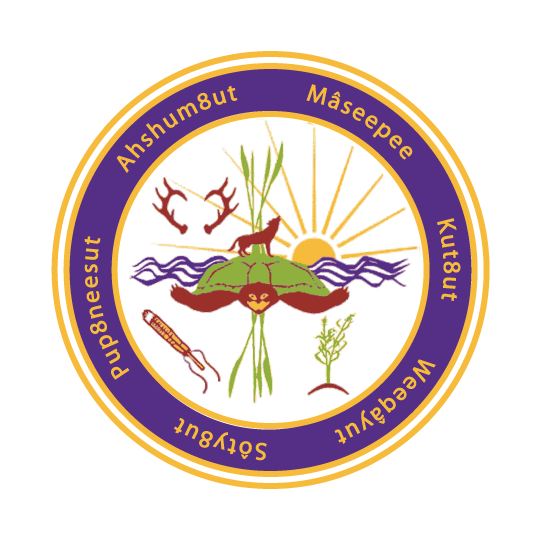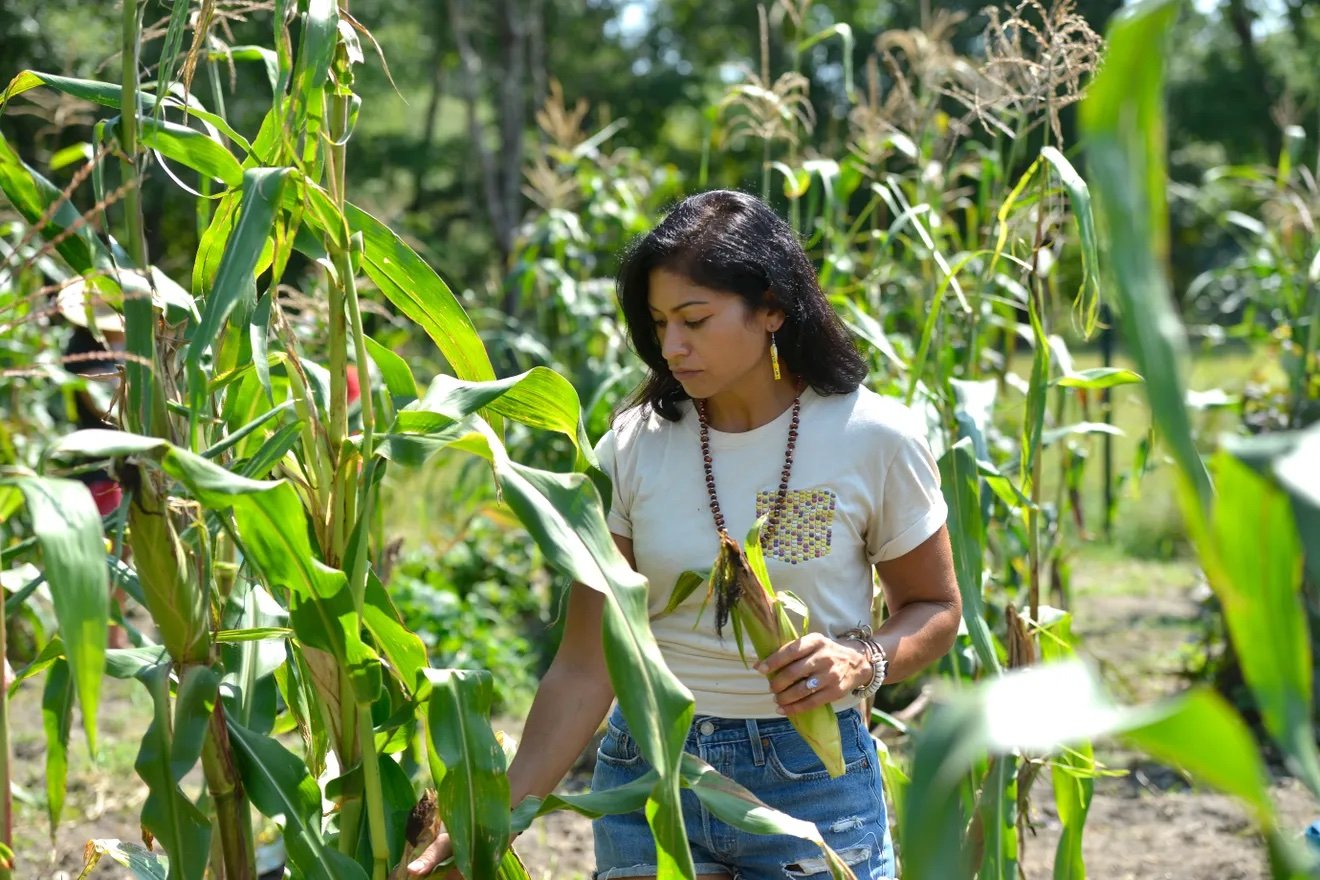Tribal Women Grow and Harvest King Philip Corn
A handful of Wampanoag women moved slowly through green, leafy corn fields on Monday, carefully freeing endangered King Philip corn cobs from the 10-foot-tall stalks that spread across Maushop Farm.
Lauren Peters, a Mashpee Wampanoag Tribal member, gently cracked a husk open and revealed gleaming rows of amber-colored corn kernels. This is Peters' third season growing the eight-row flint corn, but it's the first time in decades that the strain of corn has been grown by a cohesive group of tribal women.
"This harvest is an illustration of how much love, care and community went into the land. As we worked together, we were able to revive ancestral knowledge," said Lauren.
Since April, women from the Wampanoag Nation, the Narragansett Indian Tribe and the Shinnecock Nation have met to revive the growth of the corn.
The King Philip corn variety is named after Wampanoag intertribal leader Metacom, who was also known as King Philip. As she held her baby in one hand, and plucked corn from its stalk with the other, Danielle Greendeer explained that the corn was given to Europeans by Wampanoag people throughout the early days of English settlement. Much of it was destroyed during King Philip's War in 1675, and the strain almost went extinct during the rise of industrialized agriculture.
Danielle, a Mashpee Wampanoag tribal member and author of "Keepunumuk Weeâchumun's Thanksgiving Story," learned how to grow King Philip corn in Wisconsin in 2017, along with other strains like green oaxacan, and glass gem. In 2020, Greendeer brought that knowledge back to Mashpee. It became a dream, said Greendeer, to teach other tribal members how to grow King Philip corn.
"My original goal of rematriating (King Philip corn) to our tribal community is happening," said Danielle.
Since April, Peters and Greendeer, along with women from the Wampanoag Nation, the Narragansett Indian Tribe, and the Shinnecock Nation have met consistently throughout the spring and summer to nurture the corn, along with other crops in the three sisters garden, including beans, and squash. "It's been a powerful experience teaching tribal women how to grow food," said Peters.
Marlene Lopez, a Mashpee Wampanoag clan mother, meticulously unwound deep purple string beans from a corn cob during Monday's harvest. When she paused, she said the successful corn harvest symbolizes feminine energy. While much of the corn will be ground into flour, she said the multi-colored corn kernels can also be used for a litany of projects, including jewelry making.
"The work put into this harvest shows that women can come together and nurture the ancestors," said Marlene. "It's an example of how important feminine energy is. We are on feminine land. The land itself is feminine. And then the corn and the women themselves."
The growing process for the corn has been hands on, said Peters and required consistency, research and cooperation. Almost daily throughout the summer, Peters jogged a five-mile loop from her family home in Mashpee to Maushop Farm to check on the three sisters garden. Sometimes, she said, she was in the fields for up to nine hours a day — especially when she was infusing nutrients into the soil.
"There was a lot of trial and error," said Peters.
She also practiced three-sister growing techniques, monitored water quality and straddled the traditional science surrounding Native plants, she said.
"It's tedious but the growing process helps women of all ages heal, and build confidence," said Peters. "Getting our hands dirty and making time for traditional work is a win-win situation."
Just before harvest, Peters ran to the farm only to find that local deer had eaten almost an entire field of corn. While she was initially dismayed to find many of the cobs nibbled and chewed by the herd, the deer's interest in the King Philip strain was an indication that the group had grown the corn correctly. "I realized that if the animals weren't eating the corn, it would be a bad thing," said Peters.
The deer, said Greendeer, recognized that Wampanoag corn is back.
"In a holistic way, we are not just feeding ourselves as humans, but all our relations," she said.
Anita "Mother Bear" Peters, an elder and Mashpee Wampanoag clan mother, was also on hand to harvest this year's crop.
"I was lucky to have my great-grandmother alive until I was a teenager," said Anita Peters. "She would take us out and show us where the best blueberry patches were, and what each medicinal plant was. We learned that growing food is a type of healing ceremony."
Lauren Peters lamented on her own childhood in the early 1990s. Every week during the summer, Winona "Noni" Hendricks, a member of the Nipmuc and Mashpee Wampanoag tribe, would pack her magenta-colored Dodge minivan with tribal girls, and take them fishing, clamming and planting.
"Some of us didn't have a mother or a female figure to look up to in our lives," said Lauren Peters. "Noni taught us how to be women. She infused us with confidence and taught us how to be ladies. She even taught us how to walk in heels."
Hendricks, who died in August of 2022, also taught the group how to stay grounded.
"She taught us how to handle our emotions," said Lauren Peters. "She would say, 'Go out into the woods when you are upset. Don't do anything when you are angry. Go to the woods and heal before you come back.'"
Marlene Lopez picks off an ear of corn Monday afternoon. A group of women were harvesting King Philip corn at the Mashpee Wampanoag Tribe's farm Monday afternoon.
The concept behind the three sisters: corn, beans and squash was also important to Hendricks, said Lauren Peters. The crops treat each other like family and support one another in the field. Just like the three sisters, Hendricks reminded the group of girls that they need to support and care for one another.
"Each of us has our own special medicine and we need to remember to highlight what that special medicine is," she said.
In their adult lives, the fields have become a place for "Noni's girls" — who are now adult women — to find peace, said Lauren Peters.
"It’s the first time in a long time I’ve seen that happen in our community and I want it to happen more often," she said.
Throughout the season, tribal men also became involved by delivering rabbit manure and sopping wet seaweed to the garden beds to help pump nutrients into the soil.
"The whole community felt involved and wanted to be a part of this," she said.
As young children zipped around the farm, Greendeer talked about plans for a corn watch tower, which was used during the growing season by the Wampanoag Tribe before European colonization. The purpose of the structure, which she described as a "prehistoric jungle gym," was to simultaneously entertain children and deter crows and deer from the planting fields.
"The corn watch tower was almost like a tree house but with no trees," she said. "It provided shade and gave the kids something to do."
The group also hopes to revive traditional tribal corn songs, and corn dances, said Greendeer.
For Greendeer, the commitment the group made to the corn is inspiring. It's not a tribal job, she said. No one was paid for their efforts.
"This was consistent time, love and energy that people sunk into community development, cultural revitalization, and food sovereignty," she said. "The reward was the harvest. And, to me, that's the most important part. Even if we got one cob of corn, it would've been worth it."
Rachael Devaney CCT




